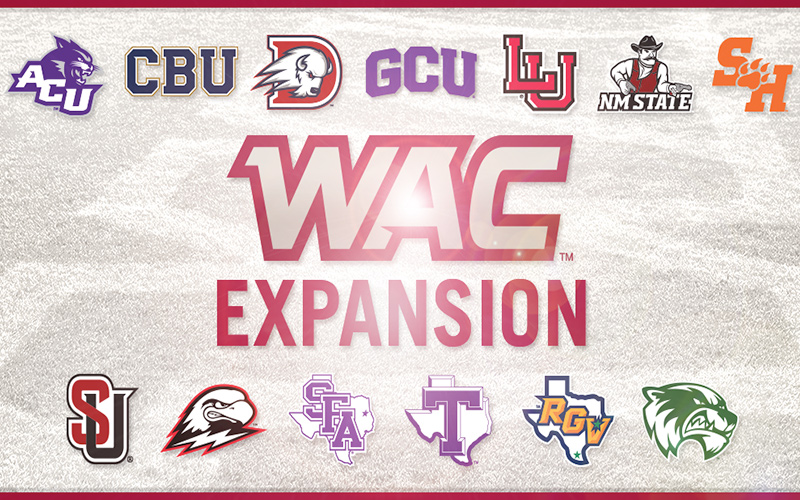
The Western Athletic Conference announced in January that it is adding five school. Joining the WAC from the Southland Conference will be Abilene Christian University, Lamar University, Sam Houston State University and Stephen F. Austin State University, all located in Texas, while Southern Utah University will join from the Big Sky Conference. (Photo courtesy of Western Athletic Conference)
PHOENIX — The Western Athletic Conference will tighten its borders along America’s Sun Belt. In January, the WAC announced that over the next two years, five schools will join the conference, upping the total of full members to 13.
Abilene Christian, Lamar, Sam Houston State and Stephen F. Austin State join the WAC from the Southland Conference, while Southern Utah switches from the Big Sky Conference.
This move marks the end of an era that began in 2013, when seven schools joined the conference. Chicago State, Missouri-Kansas City, Grand Canyon and Utah Valley came into the fold. GCU and Utah Valley hail from states where the WAC had outposts at some point in its history, while UMKC and Chicago State stuck out like sore thumbs. The hope inside the conference was that the eventual next chapter of expansion would feature other Midwest schools to complement UMKC and Chicago State.
When that frontier never opened, the conference went to an already successful model for realignment and elevated high-performing Division II institutions. Currently, five WAC members used to compete at the DII, NAIA or junior college ranks.

First-year coach Bryce Drew led the Grand Canyon men’s basketball team to its first Western Athletic Conference title. It begins NCAA Tournament play Saturday. (Photo courtesy of Grand Canyon Athletics)
“The highest performing Division II schools are probably putting more into athletics than some of the lagging Division I schools,” said Josh Hauser, GCU men’s basketball sports information director. “So if you can get a school like Grand Canyon or California Baptist that are really intent on competing in high-level Division II athletics, they’re probably prime candidates to move to the next level and do the same thing at the Division I level.”
This decision was as much about competition as economics.
“We wanted to be in states that were growing: Arizona’s growing, Texas is growing, Utah has seen a huge economic shift,” Hauser said. “So what that says is that, ‘Hey, these schools, especially the ones that are public, state schools, are going to have a big enough population base to support universities at high level, and support athletics at a high level at the same time.’”
Texas and Utah have each seen increases in state-wide GDP annually from 2013 to 2019, according to the Bureau of Economic Analysis. The newcomers vary in size – Sam Houston State’s 30,032 undergraduate student body is among the top in Texas while Dixie State’s 12,043 is the second-smallest in Utah – but they meet a certain “passion-per-capita” quotient.
“It wasn’t just like plucking random schools that thought they’d be good DI fits. It was very intentional, like Tarleton is in a small city in Texas that just loves their sports,” Hauser said. Community support turns into ticket sales, which turns into facilities.
“Dixie State already had a DI-level arena; California Baptist, right before transitioning to DI, just built a brand-new arena. So these are schools that are intent on competing and not just happy to be here in DI,” Hauser said.
This is just the latest era of WAC realignment. By the time the five new full-member schools join in 2023, the WAC will have had 56 members of varying membership levels in its history.
Conference realignment is a sign of the times in a lot of ways, as individual schools’ athletic programs – or even specific sports – gain or lose notoriety. ESPN senior writer and the brain behind Bracketology, Joe Lunardi, fondly remembers a time when the WAC regularly had national brands.
“The WAC that I grew up with had UNLV and BYU and Utah and New Mexico. They had Final Four programs,” he said. “And certainly times have changed, and that’s OK, but they have fallen so far that, if not for New Mexico State in recent years, they’ve been pretty irrelevant.”
Lunardi isn’t wrong. In the late 20th century, the WAC had seven members that won 31 national championships across 10 NCAA-sanctioned sports, namely Brigham Young’s recognition as the 1984 football champs, Arizona State’s first four baseball championships, and Arizona’s first baseball title in 1976. None of the WAC’s seven national championship-winning schools are currently members of the conference. That doesn’t even include the 19 championships won in non-NCAA sports by ASU, Utah and Texas-El Paso.
For the WAC, getting closer to national notoriety starts with men’s basketball. There’s no better model than GCU this year.

Grand Canyon players Mikey Dixon (left) and Ethan Spry leap in the air after the Lopes captured the Western Athletic Conference men’s basketball title in Las Vegas and earned a berth to the NCAA Tournament, their first. (Photo by Joe Buglewicz/Getty Images)
The 2020-21 campaign was the most irregular in the sport. COVID-induced pauses, completely reworked schedules and bubble environments made this season challenging. And still, the Lopes won. For the first time in program history, GCU won the WAC regular season and tournament titles, and clinched a spot in the NCAA Tournament at the DI level.
Maybe the COVID season (the first full one, at least) gave first-year coach Bryce Drew some grace that predecessor Dan Majerle didn’t receive. It certainly presented Drew challenges that Majerle couldn’t have ever conceived. And still, with 17 wins – just the third-lowest total since the program elevated – Drew coaching the team to the tournament is the signature accomplishment that Majerle wasn’t able to achieve. Timing is everything.
In a lot of ways, GCU’s trajectory since elevating to DI in 2013 is what the conference looks to replicate collectively and school by school. By adding the newest five schools, the conference is trying to become a league that earns multiple bids in the NCAA Tournament. Conference commissioner Jeff Hurd said of the announcement that it “enhances the WAC basketball brand.” More teams mean more revenue shares split among conference members. The further a team advances adds to that pot. For the individual programs, they want to be the perennial contenders, not just one team in a league only relevant in March.
This year, more than ever, revenue shares are the primary focus for everyone involved: from GCU all the way up to the NCAA.
The NCAA’s insurance policy on the 2020 Tournament covered only $270 million of an $800 million in lost revenue, Dennis Dodd of CBS Sports reported. Of that expected $800 million, “only $225 million of an anticipated $600 million marked for the membership was then distributed.”
That $225 million was split 68 ways, so each school made about $3.3 million. At least 12 DI coaches make more than that annually.
Of course the biggest schools, the state schools or the winningest programs punch different numbers in their calculators than the rest. As Dodd wrote, an inverse relationship exists between how good a team is and how heavily the school relies on tournament revenue. It exists at the conference and national levels.
Schools and conferences can mitigate that in both the short and long terms (COVID-era included) by getting in the tournament. Whether by winning a conference tournament (like GCU did this year) or being selected by the NCAA’s Selection Committee as an at-large bid (how ASU and UArizona most recently appeared in the 2019 Tournament), getting in requires wins.
Not all wins are equal, though, and they aren’t all available equally. Metrics like ESPN’s BPI or the NCAA’s nascent NET are a couple of ways to quantify the disparities from team to team. Regardless of what ranking one looks at, what’s consistent is an emphasis on wins against good teams, a necessity for wins against teams you’re better than, and losses only to the teams better than you. The WAC’s incoming schools will raise the conference’s competition level not just in theory, but statistically.
“The leagues have continuity of membership criteria that have to be met in order to maintain their automatic bid,” Lunardi said. “If you’re adding schools from another league that have it, it helps with your math. And if you add brand new schools, it can, for a short period of time, hurt your math. And I think the WAC has been very strategic that way.”
The WAC forecasts elevated competition to appear in advanced metrics. “Over the previous three fully completed years, the average team ranking of the WAC’s future structure would have improved by 20 spots in men’s basketball, 45 spots in women’s basketball and 24 spots in baseball,” the conference said in a press release.
To Lunardi, GCU has taken the lead among the WAC in both standings and strategic planning.
“What they’ve done clearly at a level maybe not commensurate with recent WAC schools, is they’ve invested in basketball,” he said. “It’s in terms of scheduling, in terms of who they’ve hired and retained, and how you resource your program and certainly elevate your fan experience.”
Lunardi warns that especially after the last two seasons of COVID complications, the tried-and-true practices of heavy investments might not work, though.
“It doesn’t always work that the more you spend, the more you win, right? Case in point: the New York Mets,” he said. “There have been teams in sports that have spent their way into oblivion. Obviously, intercollegiate athletics is a little bit different because at least publicly you’re not buying players.”
Building a championship program means national championship expectations. Simply making the NCAA Tournament does not automatically elevate the program to national championship status, especially for a mid-major program. UCLA boasts the most national championships with 11, but it took them 14 years from their first appearance to win the whole thing. Of course that 1964 win started a 10-titles-in-12-years run, so maybe it’s a bit of a high standard.
For GCU, as a program, and the WAC, as a conference, the next step is making sure this first NCAA Tournament run isn’t the last.
